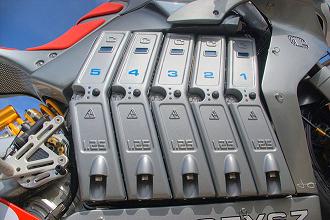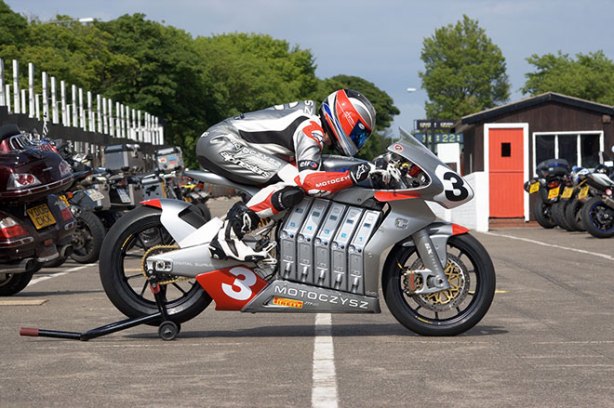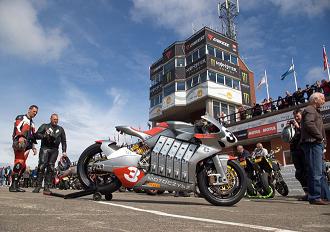 You want to buy a camera? We can pit it against three others with nearly indistinguishable features, no problem. Blu-ray players? We’ll compile a three-axis matrix that triangulates the perfect combination of image quality, connected functionality and price. But if you’re considering the Bugatti Veyron 16.4 Grand Sport, we can’t do much for you.Comparing it to any other car is pointless, because there is nothing else in its $2.1-million (based on current exchange rates) class. That same cash-filled briefcase could buy seven Ferrari 599s or every single 2009 model Mercedes. You could snap up a top-shelf Maybach and employ a chauffeur until well past the apocalypse. Hell, in this economy, $2.1 million is probably enough to make you a one-man special-interest group with some serious Washington clout.But don’t. Buy a Grand Sport. Even if there were another 253-mph drop-top with more luxury appointments than a Bond villain’s boudoir, you wouldn’t want it. You’d want this exact car, because more than being a blast to drive, it is the greatest gasoline-powered vehicle that has ever been, or will ever be, built. Seriously. Take a moment and consider what Bugatti has done: Because a handful of billionaires demanded that the fastest car in the world be available topless, the Volkswagen-owned ultra-luxury automaker essentially broke the laws of physics. Again.The first Veyron is an engineering marvel. That’s the one with the massively reinforced roof that helped keep the rest of the body from deforming into an amoebic tangle of graphite composite and exotic metal under the joint stresses of lateral acceleration, horsepower and wind. It stands as one of the greatest achievements of the petroleum age. It required the intellectual might of one of the largest and arguably smartest car companies in the world to birth a car that was not only faster than anything on the road, but easy enough to pilot that anyone could drive it. (“It killed my husband” is not the kind of country-club buzz that sells cars.) To make the Grand Sport, Bugatti’s engineers had to do the same thing, only with a giant hole in the middle. It was like designing a picture frame to break rocks.
You want to buy a camera? We can pit it against three others with nearly indistinguishable features, no problem. Blu-ray players? We’ll compile a three-axis matrix that triangulates the perfect combination of image quality, connected functionality and price. But if you’re considering the Bugatti Veyron 16.4 Grand Sport, we can’t do much for you.Comparing it to any other car is pointless, because there is nothing else in its $2.1-million (based on current exchange rates) class. That same cash-filled briefcase could buy seven Ferrari 599s or every single 2009 model Mercedes. You could snap up a top-shelf Maybach and employ a chauffeur until well past the apocalypse. Hell, in this economy, $2.1 million is probably enough to make you a one-man special-interest group with some serious Washington clout.But don’t. Buy a Grand Sport. Even if there were another 253-mph drop-top with more luxury appointments than a Bond villain’s boudoir, you wouldn’t want it. You’d want this exact car, because more than being a blast to drive, it is the greatest gasoline-powered vehicle that has ever been, or will ever be, built. Seriously. Take a moment and consider what Bugatti has done: Because a handful of billionaires demanded that the fastest car in the world be available topless, the Volkswagen-owned ultra-luxury automaker essentially broke the laws of physics. Again.The first Veyron is an engineering marvel. That’s the one with the massively reinforced roof that helped keep the rest of the body from deforming into an amoebic tangle of graphite composite and exotic metal under the joint stresses of lateral acceleration, horsepower and wind. It stands as one of the greatest achievements of the petroleum age. It required the intellectual might of one of the largest and arguably smartest car companies in the world to birth a car that was not only faster than anything on the road, but easy enough to pilot that anyone could drive it. (“It killed my husband” is not the kind of country-club buzz that sells cars.) To make the Grand Sport, Bugatti’s engineers had to do the same thing, only with a giant hole in the middle. It was like designing a picture frame to break rocks.
They had to bolster the floor, doors and B pillars (where the back edges of the windows rest) with acres of carbon fiber. They had to turn the topside air scoops into structural supports for protection during a rollover. Then they had to sacrifice 100 virgins and have the production facility in Molsheim, France, blessed by druids.The result is the most structurally rigid convertible in the world, which, miraculously, weighs no more and goes no slower than the coupe on which it is based. With the transparent roof removed, air resistance limits the Grand Sport to 217 mph, but you’d want that roof on for a top-speed run anyway; the wind could rip your face off at around 245.
By now, the Veyron’s stats are legendary: 1,001 horsepower from a mid-mounted, 8.0-liter, 16-cylinder engine that gets air stuffed down its ravenous gullet by four massive turbochargers. All-wheel drive. A seven-speed, dual-clutch transmission that switches gears faster than a state staffer ducking questions about the Appalachian Trail. Depending on how you define “production car,” it is the fastest in the world. In the quickest Lamborghini ever produced, the Murcielago LP640, you can hit 60 mph in 3.2 seconds. In the Grand Sport it takes a hair under 2.5. How does it feel to command that pace? Godlike.The acceleration is so immediate you can feel your eyeballs deform under the G-forces. It’s a sensation of isolationist joy, an out-of-body awareness that you’re moving faster than the world can react. Bystanders vaguely remember seeing a flash of expensive paint a few seconds after you disappear over the horizon; entire generations of insects die on your prow. Passing other motorists becomes a dangerous entitlement that has you resenting oncoming traffic for hogging your “VIP lane” — especially when you realize that you can outrun not only the 5-0’s cruisers, but their helicopters, too. If they wanna catch you, they’re gonna have to dust off Airwolf and drag Jan Michael Vincent out of rehab.
But this isn’t just some dumb auto-jock that takes off from stoplights in a hail of shredded asphalt, molten Michelins and screaming revs. If anything, the exhaust note is a bit tame, and the power is manageable. Unlike driving, say, a Viper SRT-10, you’re not in constant fear of accidentally going around a turn ass-end first because you blipped the go-pedal a half-inch too deep. Though the Veyron has almost twice as much power as the super-snake, its all-wheel-drive and 14-inch-wide tires grip the ground with the tenacity of a junkie clutching a five-dollar bill.
A lot of factors contribute to this prodigious hunker-down: the aforementioned tires (Michelin developed them specifically to accommodate the Veyron’s top speed) and AWD; the giant mid-mounted engine, placed to provide perfect 45/55 weight distribution; the insanely advanced aerodynamics and suspension, which automatically change the shape and ride-height of the car to provide an extra 800 pounds of downforce when you exceed 137 miles per hour (they’d be illegal in Formula 1 competition, incidentally). And then there’s the sheer mass: Though its power-to-weight ratio bests the Ferrari F430 by almost 50 percent, the Veyron, at 4,400 pounds, is still more than half a ton heavier. And gravity is one tenacious bitch. This car sticks to the ground like 1,000-horsepower gum.
Push the Grand Sport hard, and the rear-biased AWD will start to feel looser, making the car light and nimble through the twisties. But even when attacking some seriously hairy turns from deep in triple digits, the Veyron never gave up its grip. And when we almost blew it on a butt-puckering downhill double-apex, the all-wheel-drive system put power in just the right place to pull the car back in line. All while we sat comfortably in bucket seats that made our couch seem fit only for the waiting room of the DMV.
Bugatti offers seven different seat shapes, to accommodate the seven known varieties of billionaire: lust, gluttony, greed, sloth, wrath, envy and pride. Each is based around a carbon-fiber shell and available in whatever animal skin the laws of your kingdom permit. Our test car was fitted with caramel-colored leather. It was nice, but the light hue reflected quite a bit of glare off the steep rake of the windshield. Other luxury touches include a stereo, we’re told. The CD player is custom-designed by Burmeister to operate skip-free at 250 miles per hour. We never turned it on. With the carbon fiber and polycarbonate roof removed, you have the only soundtrack you need: the engine’s growl (could be louder) and the roar of the twin air intakes, which suck air like a two rolls of quarters quart of sterno Las vegas.There’s also a navigation system. It might be the finest example of passive aggression ever assembled; Bugatti’s engineers clearly don’t want you to use it. You can only program the system with a separate, 2005-vintage PDA. If you can stomach the Windows Mobile interface long enough to set your destination, you get to view your route guidance in a tiny screen in the rearview mirror. Theoretically. As long as it’s nighttime. It’s invisible in the daylight, and the Grand Sport is a convertible.But even if its nav system shouted insults at you, it would be hard to complain about this machine. It is not perfect — no car will ever be. But it’s close. And it will likely remain as close as a car with a gasoline-burning engine will ever get. We’re at the end of the petroleum era, the end of a golden age of supercars where speed can be sought regardless of consequence. It’s highly unlikely that a major automaker will ever be able to justify spending the time and money to develop a fossil-fuel-powered car that can top the Veyron’s combination of power, speed, handling, driveability and flat-out luxury. The Grand Sport is the worthy successor to the Ferrari F40, the Lamborghini Diablo, the McLaren F1 and every other Texas tea-drinker that ever owned the title “world’s fastest.” And its high-level swank takes that prize with style points nonpareil.Maybe we’ll idolize maglevs next. Maybe Tesla will have its day on a Trapper Keeper with a juice box that tops 250. But whatever we’re drooling over next year, whatever makes its way onto the dorm-room walls and man-children’s screen-savers, it won’t run on petrol. Unless it’s still a Veyron: the last king of the gas-guzzlers, forever the greatest.
















